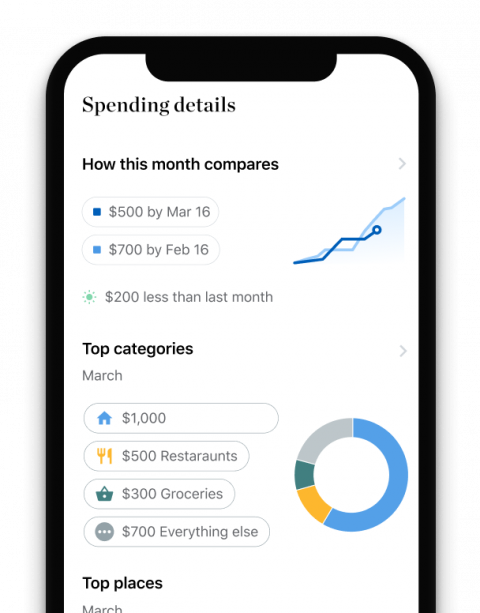

Trea S. Branch is a former NerdWallet writer focused on student loan refinancing. She holds a degree in economics from the University of Michigan and a degree in business from the University of Notre Dame. Trea shared her own student loan payoff journey through a blog, which turned into a personal finance coaching business. Her goal has been to empower anyone overwhelmed by student debt.
Lead Assigning Editor Karen Gaudette Brewer
Lead Assigning Editor | Core Personal Finance
Karen Gaudette Brewer leads the Core Personal Finance team at NerdWallet. Previously, she guided students and their families through the ins and outs of paying for college and managing student debt on the Higher Education team. Helping people navigate complex money decisions and feel more confident brings her great joy: as the daughter of an immigrant, from an early age she was the translator of financial documents and the person who called the credit card company to fix fraud.
She joined NerdWallet with 20 years of experience working in newsrooms and leading editorial teams, most recently as executive editor of HealthCentral. She launched her journalism career with The Associated Press and later worked for The (Riverside) Press-Enterprise, The Seattle Times, PCC Community Markets and Allrecipes.com.
She is a graduate of the 2022 Poynter Institute Leadership Academy for Women in Media. Her writing has been honored by the Society for Features Journalism and the Society of Professional Journalists. In addition, she’s the author of two books about the Pacific Northwest.
Fact CheckedMany, or all, of the products featured on this page are from our advertising partners who compensate us when you take certain actions on our website or click to take an action on their website. However, this does not influence our evaluations. Our opinions are our own. Here is a list of our partners and here's how we make money.
When can I update my FAFSA application? The redesigned FAFSA for the 2024-25 academic year is available at FAFSA.gov. After major delays, the FAFSA corrections process opened on April 16 to students and families who submitted incorrect or incomplete forms.
You can still submit the 2023-24 FAFSA until June 30, 2024.
Dive deeper into FAFSA
When you need to apply: Find out the FAFSA deadline How much aid you'll get: Estimate your financial aid award What's on your FAFSA checklist: What you'll need to complete the application Your financial aid letter: Understand and compare offersFor the first time in 40 years, students are seeing a completely revamped Free Application for Federal Student Aid ( FAFSA ). These changes are part of the FAFSA Simplification Act and should benefit most families, but some households could see their eligible aid decrease significantly.
The FAFSA Simplification Act aims to streamline the application process, remove barriers for key student populations and expand federal aid eligibility. Notable changes to the FAFSA include:
Replacing the Expected Family Contribution with the Student Aid Index. Expanding Federal Pell Grant eligibility. Automatically populating federal income tax data from the IRS. Adding details that determine a school's cost of attendance. Removing questions about Selective Service and drug convictions.Simplifying questions that determine the independent status of students in unusual circumstances, such as homeless students, orphans or former foster youth. Institutions will have more flexibility in adjusting certain factors that impact federal student aid for these students.
Translating the application so it will be available in more languages.The long-awaited changes soft-launched in late December and are still rolling out as the Department of Education works through technical glitches and some errors , including fixing math that could have cost students $1.8 billion in federal aid and fixing the process for students whose parents don't have Social Security Numbers to submit the FAFSA.
The Department of Education is changing how a family's need-based aid is calculated. As a result, more households could receive more aid.
Before FAFSA simplification: A family's need was calculated using the Expected Family Contribution (EFC). The EFC incorporated income and assets, family size and the number of children currently enrolled in college. Typically, the lower the EFC, the more aid you'd be eligible for.
After the FAFSA simplification: The EFC is being replaced by the Student Aid Index (SAI). And similar to the EFC, the lower the SAI, the more aid you’ll be eligible for. But the new formula increases the income protection allowance — allowing for more of a student's or family's income to be excluded from the calculation.
For example, using the EFC, the parent income protection allowance for a family of four for the 2023-24 academic year is $32,610. For the 2024-25 school year, the same family can exclude $35,870 — protecting an additional $3,260 from their income calculation and lowering the student's SAI.
Moving away from the EFC to the SAI, it will be easier for some households to show the magnitude of their financial need.
Before FAFSA simplification: Students from a household with limited income and assets could, at the lowest limit, receive an EFC of zero. If your EFC was zero, you were automatically eligible for the maximum amount of federal student aid.
Cost of attendance - EFC = Financial need
For example, if your school's cost of attendance is $20,000 and your EFC is zero, you would be eligible for $20,000 in need-based aid.
After FAFSA simplification: Unlike the EFC, the new SAI calculation can drop below zero. The SAI can be as low as -1,500. A family with significantly fewer financial resources could receive more aid in the 2024-25 academic year than they were eligible to receive in the 2023-24 school year.
Cost of attendance - SAI = Financial need
Using the example above, having a $20,000 cost of attendance and an SAI of -1,500, you could be eligible for $21,500 in need-based aid — an increase of $1,500.
The SAI calculation also makes it easier to qualify for the Pell Grant:
If your SAI is between 0 and -1,500, you qualify for the maximum Pell Grant .If your SAI is greater than 0 but less than the maximum Pell Grant award ($7,395), you could qualify for the maximum Pell Grant — minus your SAI.
If your SAI is greater than the maximum Pell Grant award, you could still qualify for a Pell Grant depending on your family size, adjusted gross income and poverty guidelines.
Families with more than one child in college at the same time will no longer receive a sibling discount.
Before FAFSA simplification: The contribution for parents with multiple children in college was divided by the number of children enrolled. This was based on the idea that a parent's ability to pay for college doesn't increase as they have more children enrolled, according to the Department of Education.
Using an example from the Department of Education, a parent with one dependent in college full time could have an EFC of $10,000. When their second child enrolls, that child's EFC would be $5,000. If they have three children enrolled, the third child would have an EFC of $3,333, and so on.
After FAFSA simplification: The SAI does not consider the number of children enrolled in college when determining the parent's contribution.
For some families, particularly those with incomes and assets between $75,000 and $200,000, the impact of removing the sibling discount could be large. Their eligibility for financial aid could be cut by thousands of dollars, explained Phillip Levine, an economics professor at Wellesley College.
All changes to the FAFSA should be in place for the 2024-25 academic year, but you don't have to wait to take action. Use the federal student aid estimator to see what you'll be eligible to receive.
Simple tax filing with a $50 flat fee for every scenario
With NerdWallet Taxes powered by Column Tax, registered NerdWallet members pay one fee, regardless of your tax situation. Plus, you'll get free support from tax experts. Sign up for access today.
Register Nowfor a NerdWallet account
About the authorYou’re following Trea Branch
Visit your My NerdWallet Settings page to see all the writers you're following.
Trea. S. Branch is a former NerdWallet writer who covered higher education and the student debt crisis. See full bio.
On a similar note.

Download the app
Disclaimer: NerdWallet strives to keep its information accurate and up to date. This information may be different than what you see when you visit a financial institution, service provider or specific product's site. All financial products, shopping products and services are presented without warranty. When evaluating offers, please review the financial institution's Terms and Conditions. Pre-qualified offers are not binding. If you find discrepancies with your credit score or information from your credit report, please contact TransUnion® directly.
NerdUp by NerdWallet credit card: NerdWallet is not a bank. Bank services provided by Evolve Bank & Trust, member FDIC. The NerdUp by NerdWallet Credit Card is issued by Evolve Bank & Trust pursuant to a license from MasterCard International Inc.
Impact on your credit may vary, as credit scores are independently determined by credit bureaus based on a number of factors including the financial decisions you make with other financial services organizations.
NerdWallet Compare, Inc. NMLS ID# 1617539
California: California Finance Lender loans arranged pursuant to Department of Financial Protection and Innovation Finance Lenders License #60DBO-74812
Insurance Services offered through NerdWallet Insurance Services, Inc. (CA resident license no.OK92033) Insurance Licenses
NerdWallet™ | 55 Hawthorne St. - 10th Floor, San Francisco, CA 94105